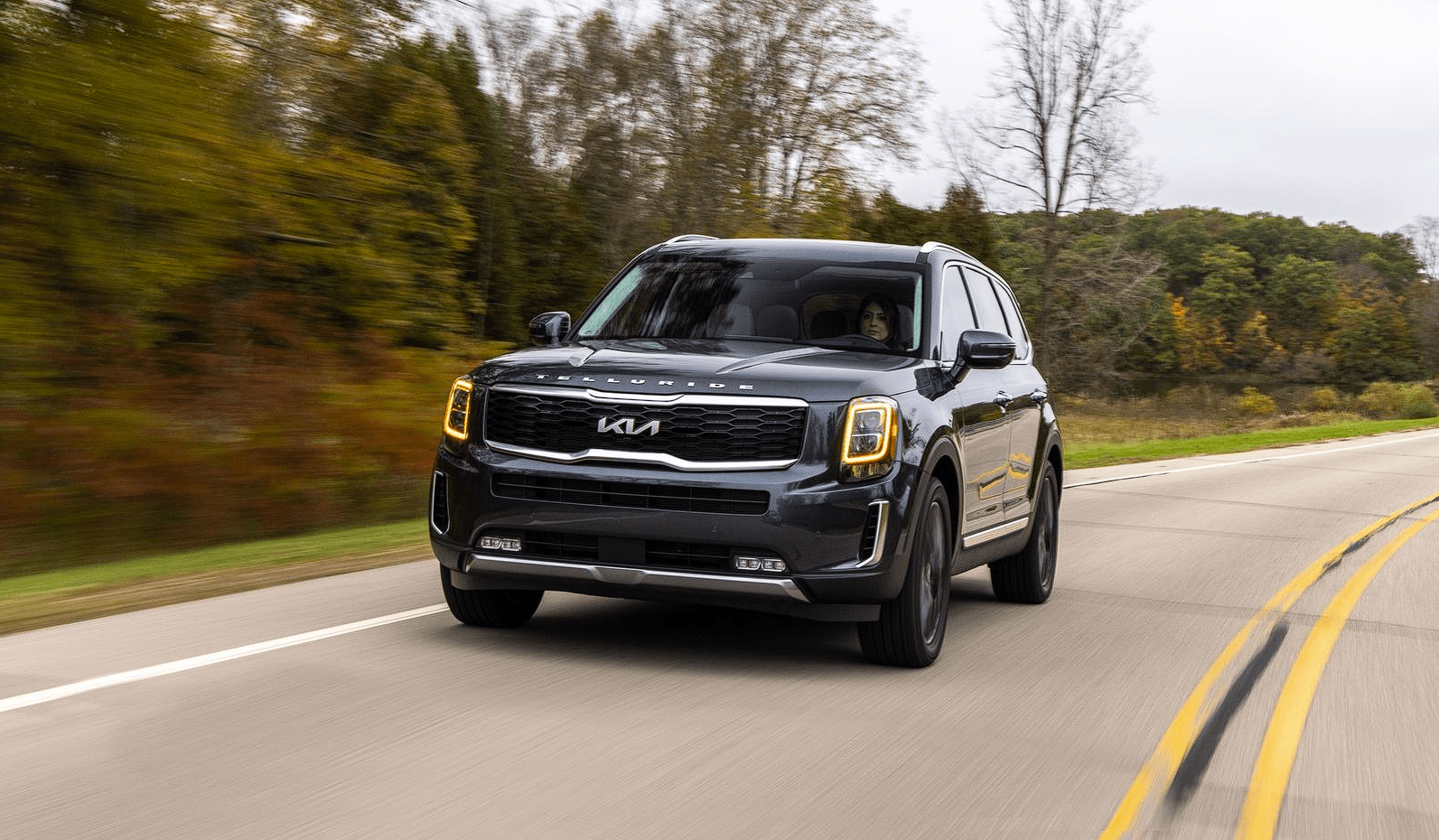2022 Kia Telluride Rear Cross-Traffic Collision-Avoidance Assist
In the 2022 Kia Telluride, a key safety feature called Rear Cross-Traffic Collision-Avoidance Assist (RCCA) is added. This shows that Kia is even more dedicated to protecting passengers and making driving easier. The RCCA is a big step forward in car technology that is meant to give people peace of mind when they are backing out of garages or parking spots. With the help of a complex network of sensors, which are usually hidden in the rear bumper, this system constantly checks the area for cars coming from the sides. When the RCCA sees or hears a possible collision risk, they quickly tell the driver through visual and audible cues, giving them plenty of time to avoid an accident. With its ability to lower the risk of accidents in places where visibility may be low, like crowded streets or busy parking lots, the 2022 Kia Telluride with RCCA shows how committed Kia is to making cars safer and more convenient for drivers and passengers, setting a new standard for SUVs in the modern era.
2023 Kia Telluride Specs, Price, Features and Mileage (Brochure)
Rear Cross-Traffic Collision-Avoidance Assist (RCCA)
Rear Cross-Traffic Collision-Avoidance Assist is designed to detect vehicles approaching from the left and right side while your vehicle is reversing and warn the driver that a collision is imminent with a warning message and an audible warning. Also, to help prevent collision braking assist is applied.
[A]: Rear Cross-Traffic Collision Warning operating range
[B]: Rear Cross-Traffic Collision-Avoidance Assist operating range
CAUTION
The time of warning may vary depending on vehicle speed of the approaching vehicle.
Detecting sensor
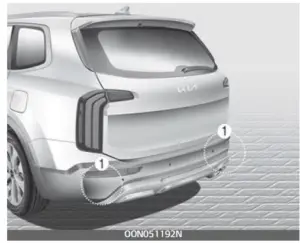
[1]: Rear corner radar
Refer to the picture above for the detailed location of the detecting sensor.
Rear Cross-Traffic Collision-Avoid-ance Assist Settings
Setting features
Rear Cross-Traffic Safety
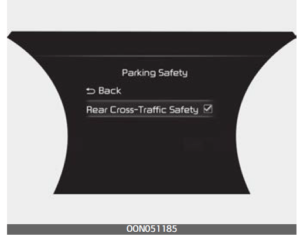
With the ENGINE START/STOP button in the ON position, press MODE
button ( ) several times on the
steering wheel until User Settings menu appears on the LCD display. Select Driver Assistance → Parking Safety → Rear Cross-Traffic Safety from the setting menu to set whether or not to use each function.
WARNING
When the engine is restarted, Rear Cross-Traffic Collision-Avoidance Assist will always turn on. However, if ‘Off’ is selected after the engine is restarted, the driver should always be aware of the surroundings and drive safely.
NOTICE
Settings for Rear Cross-Traffic Safety system include Rear Cross-Traffic Collision Warning and Rear Cross-Traffic Collision-Avoidance Assist.
NOTICE
If the engine is restarted, Warning Timing and Warning Volume will maintain the last setting.
Warning Timing

With the ENGINE START/STOP but-ton in the ON position, press MODE
button ( ) several times on the
steering wheel until User Settings menu appears on the LCD display. Select Driver Assistance → Warning Timing to change the initial warning activation time for Rear Cross-Traffic Collision-Avoidance Assist.
When the vehicle is first delivered, warning timing is set to Normal. If you change the warning timing, the warning time of other Driver Assisance system may change.
Always be aware before changing the warning timing.
Warning Volume
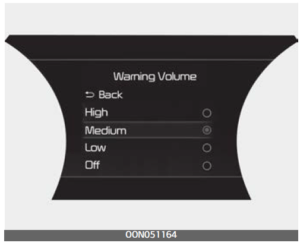
With the ENGINE START/STOP button in the ON position, press the MODE
button ( ) several times on the steering wheel until User Settings menu appears on the LCD display. Select Driver Assistance → Warning Volume to change the warning volume to High, Medium, Low or Offord Rear Cross-Traffic Collision-Avoidance Assist.
If you change the Warning Volume, the Warning Volume of other Driver Assistance systems may change.
CAUTION
- The setting of the Warning Timing and Warning Volume applies to all functions of Rear Cross-Traffic Collision-Avoidance Assist.
- Even though Normal is selected for Warning Timing, if the vehicles from the left and right side approach at high speed, the initial warning activation time may seem late.
- Select Late for Warning Timing when traffic is light and when driving speed is slow.
Rear Cross-Traffic Collision-Avoidance Assist Operation
Warning and Control
Rear Cross-Traffic Collision-Avoidance Assist will warn and control the vehicle depending on collision level: ‘Collision Warning’, ‘Emergency Braking’.
Collision Warning
Left
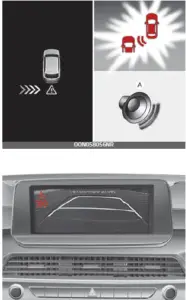
Right
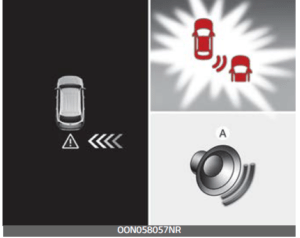
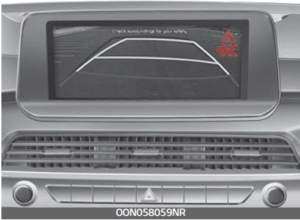
- To warn the driver of an approaching vehicle from the rear left/right side of your vehicle, the warning light on the side view mirror (outside mirror) will blink and a warning will appear on the cluster. At the same time, an audible warning will sound.
- The function will operate when the following conditions are satisfied:
- Your vehicle gear is shifted to R (Reverse)
- Your vehicle speed is below 7 mph (10 km/h)
- The approaching vehicle is within approximately 82 ft. (25 m) from the left and right side of your vehicle
- The speed of the vehicle approaching from the left and right is above 3 mph (5 km/h)
NOTICE
If the operating conditions are satisfied, there will be a warning whenever the vehicle approaches from the left or right side even though your vehicle speed is 0 mph (0 km/h).
Emergency Braking
Left
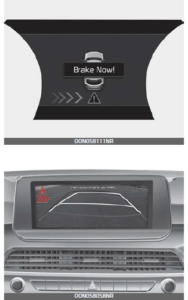
Right

- Your vehicle, the warning light on the side view mirror (outside mirror) will blink and a warning message will appear on the cluster. At the same time, an audible warn-ing will sound.
- The function will operate when the following conditions are satisfied:
- Your vehicle gear is shifted to R (Reverse)
- Your vehicle speed is below 7 mph (10 km/h)
- The approaching vehicle is within approximately 5 ft. (1.5 m) from the left and right side of your vehicle
- The speed of the vehicle approaching from the left and right is above 3 mph (5 km/h)
- Emergency Braking will be assisted to help prevent collision with approaching vehicles from the left and right.
WARNING
- Brake control will end when:
- The approaching vehicle is out of the detecting range
- The approaching vehicle passes behind your vehicle
- The approaching vehicle does not drive toward your vehicle
- The approaching vehicle speed slows down
- The driver depresses the brake pedal with sufficient power
Stopping the vehicle and ending the brake control
- For your safety, the driver should depress the brake pedal immediately and check the surroundings.
- Brake control will end after the vehicle is stopped by emergency braking for approximately 2 seconds.
- During emergency braking, braking control by Rear Cross-Traffic Collision-Avoidance Assist will automatically cancel when the driver excessively depresses the brake pedal.
WARNING
- For your safety, change the settings after parking the vehicle at a safe location.
- If any other function warning message is displayed or an audible warning is generated, Rear Cross-Traffic Collision-Avoidance Assist warning message may not be displayed and audible warning may not be generated.
- You may not hear the warning sound of Rear Cross-Traffic Collision-Avoidance Assist if the surrounding is noisy.
- Rear Cross-Traffic Collision-Avoidance Assist may not operate if the driver applies the brake pedal to avoid collision.
- During Rear Cross-Traffic Collision-Avoidance Assist operation, the vehicle may stop suddenly injuring passengers and shifting loose objects. Always have the seat belt on and keep loose objects secured.
- Even if there is a problem with Rear Cross-Traffic Collision-Avoidance Assist, the vehicle’s basic braking performance will operate normally.
WARNING
- During emergency braking, braking control by the function will automatically cancel when the driver excessively depresses the accelerator pedal.
- Rear Cross-Traffic Collision-Avoidance Assist does not operate in all situations or cannot avoid all collisions.
- Rear Cross-Traffic Collision-Avoidance Assist may warn the driver late or may not warn the driver depending on the road and driving conditions.
- The driver should hold the responsibility to control the vehicle. Do not solely depend on Rear Cross-Traffic Collision-Avoidance Assist. Rather, maintain a safe braking distance, and if necessary, depress the brake pedal to reduce driving speed or to stop the vehicle.
- Never deliberately operate Rear Cross-Traffic Collision-Avoidance Assist on people, animals, objects, etc. It may cause serious injury or death.
CAUTION
The brake control may not operate properly depending on the status of ESC (Electronic Stability Control). There will only be a warning when:
- The ESC (Electronic Stability Control) warning light is on
- ESC (Electronic Stability Control) is engaged in a different function
NOTICE
The driver must immediately depress the brake pedal and check vehicle’s surroundings.
- Brake control will end when the driver depresses the brake pedal with sufficient power.
- After shifting the gear to R (Reverse), braking control will operate once for left and right vehicle approach.
Rear Cross-Traffic Collision-Avoidance Assist Malfunction and Limitations
Rear Cross-Traffic Collision-Avoidance Assist malfunction

When Rear Cross-Traffic Collision-Avoidance Assist is not working properly, the Check Blind-Spot Collision Warning (BCW) system warn-ing message will appear on the cluster, and the function will turn off automatically or the function will be limited. In this case, have your vehicle inspected by an authorized Kia dealer.
Rear Cross-Traffic Collision-Avoidance Assist disabled
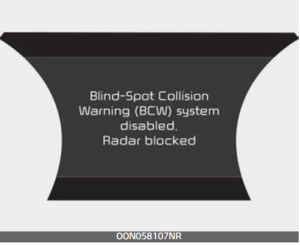
When the rear bumper around the rear corner radar or sensor is covered with foreign matters, such as snow or rain, or installing a trailer or carrier, it can reduce the detecting performance and temporarily limit or disable Rear Cross-Traffic Collision-Avoidance Assist.
If this occurs, the Blind-Spot Collision Warning (BCW) system is disabled. Radar radar-blocked warning message will appear on the cluster. It is not a malfunction.
The function will operate normally when such foreign matters or trailer, etc. is removed.
Always keep the rearview camera and rear ultrasonic sensors clean.
If Rear Cross-Traffic Collision-Avoidance Assist does not operate normally after it is removed, have the vehicle inspected by an authorized Kia dealer.
2023 Kia Telluride Specs, Price, Features and Mileage (Brochure)
WARNING
- Even though the warning message does not appear on the cluster, Rear Cross-Traffic Collision-Avoidance Assist may not properly operate.
- Rear Cross-Traffic Collision Avoidance Assist may not properly operate in an area (e.g. open terrain), where any substance are not detected after turning ON the engine.
CAUTION
Turn off Rear Cross-Traffic Collision-Avoidance Assist to install a trailer, carrier, etc., and remove the trailer, carrier, etc. to use Rear Cross-Traffic Collision-Avoidance Assist.
Limitations of Rear Cross-Traffic Collision-Avoidance Assist
Rear Cross-Traffic Collision-Avoidance Assist may not operate normally, or the function may operate unexpectedly under the following circumstances:
- Departing from where trees or grass is overgrown
- Departing from where roads are wet
- Speed of the approaching vehicle is fast or slow Braking control may not work, the driver’s attention is required in the following circumstances:
- The vehicle severely vibrates while driving over a bumpy road, uneven road or concrete patch
- Driving on a slippery surface due to snow, water puddles, ice, etc.
- The tire pressure is low or a tire is damaged
- The brake is modified
WARNING
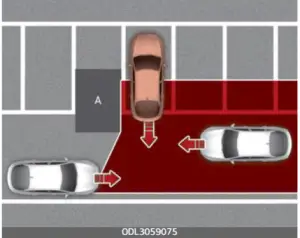
[A]: Structure
- Driving near a vehicle or structure Rear Cross-Traffic Collision-Avoidance Assist may be limited when driving near a vehicle or structure, and may not detect the vehicle approaching from the left or right. If this occurs, the function may not warn the driver or control the brakes when necessary.
Always check your surroundings while backing up.
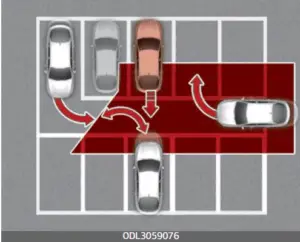
- When the vehicle is in a complex parking environment
Rear Cross-Traffic Collision-Avoidance Assist may detect vehicles that are parking or pulling out near your vehicle (e.g. a vehicle leaving beside your vehicle, a vehicle parking or pulling out in the rear area, a vehicle approaching your vehicle making a turn, etc.). If this occurs, the function may unnecessarily warn the driver and control the brake.
Always check your surroundings while backing up.
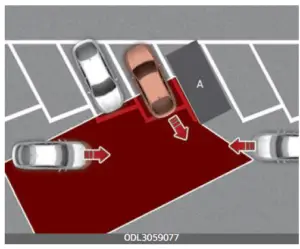
[A]: Vehicle
- When the vehicle is parked diagonally
Rear Cross-Traffic Collision-Avoidance Assist may be limited when backing up diagonally, and may not detect the vehicle approaching from the left or right. If this occurs, the function may not warn the driver or control the brakes when necessary.
Always check your surroundings while backing up.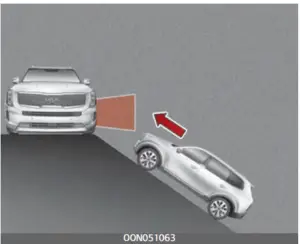
- When the vehicle is on or near a slope
Rear Cross-Traffic Collision-Avoidance Assist may be limited when the vehicle is on an uphill or downhill slope, or near it, and may not detect the vehicle approaching from the left or right. If this occurs, the function may not warn the driver or control the brakes when necessary.
Always check your surroundings while backing up.
WARNING

[A]: Structure, [B]: Wall
- Pulling into the parking space where there is a structure
Rear Cross-Traffic Collision-Avoidance Assist may detect vehicles passing by in front of you when parking backwards into a parking space with a wall or structure in the rear or side area. If this occurs, the function may unnecessarily warn the driver and control the brake. Always check your surroundings while backing up.
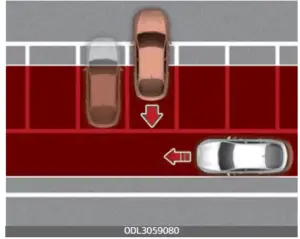
- When the vehicle is parked rear-ward
Rear Cross-Traffic Collision-Avoidance Assist may detect vehicles passing by behind you when parking backward into a parking space. If this occurs, the function may unnecessarily warn the driver and control the brake.
Always check your surroundings while backing up.
FAQ
RCCA is a safety feature designed to assist drivers in avoiding collisions when backing out of parking spaces or driveways by detecting oncoming vehicles from the sides.
RCCA uses sensors, typically located in the rear bumper, to monitor the area behind the vehicle. When it detects an approaching vehicle, it can provide visual and audible alerts to the driver.
The driver can typically enable or disable RCCA based on their preferences and specific driving situations.
Yes, RCCA is typically active when the vehicle is in reverse, as it is designed to assist with backing out of parking spaces or driveways.
RCCA is designed to detect approaching vehicles, including cars, trucks, and motorcycles, from the sides as the driver backs out.
RCCA is primarily focused on detecting vehicles and may not be designed to detect pedestrians or stationary objects behind the vehicle.
RCCA can be beneficial in parking lots, streets, and driveways, as it helps drivers avoid collisions when backing out of various locations.
RCCA enhances driver safety by providing alerts and assistance in situations where visibility may be limited when backing up.
While RCCA significantly reduces the risk of rear cross-traffic collisions, it may not prevent all such incidents, especially in extreme situations or circumstances beyond its capabilities.
RCCA is typically designed for low-speed situations, such as when the driver is backing out of a parking space or driveway.
The availability of RCCA may vary depending on the trim level and options chosen.
The driver may have the option to adjust the sensitivity of RCCA to suit their preferences and specific driving conditions.
RCCA is typically designed to function both during the day and at night, providing assistance in various lighting conditions.
Drivers should remain attentive and use RCCA as an aid rather than a substitute for safe driving practices. Checking mirrors and blind spots before reversing is still important for safety.
Useful Link
View Full User Guide: Kia Telluride 2022 User Guide
Download Manuals: https://owners.kia.com/content/owners/en/manuals.html
2023 Kia Telluride Specs, Price, Features and Mileage (Brochure)

